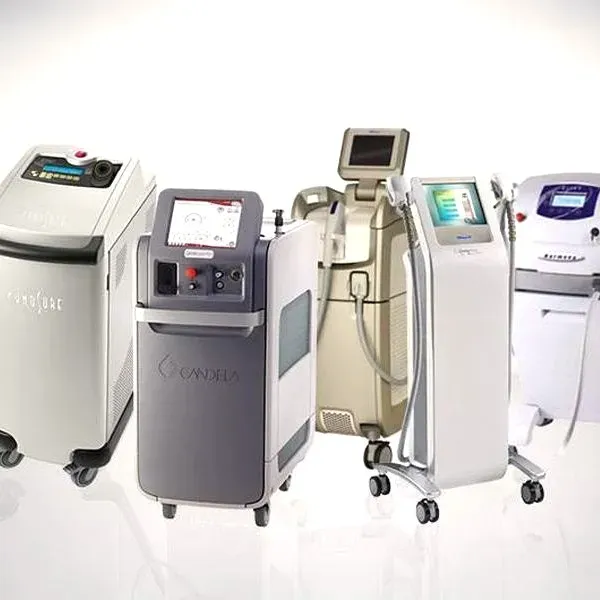Table of Contents
Tired of the endless cycle? Shaving nicks, waxing pain, the sheer time commitment of battling unwanted hair feels like a part-time job nobody asked for. You've probably heard whispers about laser hair removal – a seemingly magical solution promising smooth skin without the daily struggle. It sounds great, right? Like a permanent vacation for your razor. But step into the world of lasers, and suddenly you're faced with jargon: Alexandrite, Diode, Nd:YAG. It feels less like magic and more like a science test you didn't study for.
Understanding Laser Hair Removal Technology

Understanding Laser Hair Removal Technology
How Lasers Zapp Hair Follicles
Alright, let's break down how this whole laser hair removal thing actually works. Forget those old sci-fi movies with giant death rays. This is more like tiny, super-focused light beams. The basic idea is that the laser sends out a concentrated pulse of light. This light travels down the hair shaft, which, thanks to the pigment called melanin, acts like a little highway for the energy. When the light hits the hair follicle – that tiny pocket under your skin where hair grows from – it gets absorbed.
Think of it like wearing a black shirt on a sunny day. That black fabric absorbs the heat, right? Melanin does the same thing with the laser's light energy. This rapid absorption of energy heats up the follicle intensely. It gets hot enough, just for a fraction of a second, to damage the follicle's ability to produce hair in the future. It's not vaporizing the hair instantly like some cartoon; it's more like giving the factory a serious, potentially permanent, shutdown notice.
Why Melanin is the Star (and Sometimes the Villain)
So, we talked about melanin being the target. This is why laser hair removal works best on dark hair. Dark hair has plenty of melanin, making it an excellent conductor for that laser energy. The more melanin in the hair, the better it absorbs the light, and the more effective the treatment is at damaging the follicle. This is why people with dark hair and light skin historically saw the best results – the laser could easily differentiate between the dark pigment in the hair and the lighter pigment in the skin.
But here's the rub: melanin is also in your skin. If your skin is darker, it also contains more melanin. This means the laser can potentially heat up your skin as well as your hair follicle. This is where things get tricky and where the type of laser becomes absolutely crucial. Using the wrong laser on darker skin can lead to burns, blisters, or pigmentation changes. It's a delicate balance, hitting the hair pigment without frying the skin pigment.
- Laser targets melanin in the hair follicle.
- Dark hair has more melanin, absorbs more energy.
- Skin also contains melanin; requires careful targeting.
- Wrong laser = potential skin damage.
- Requires multiple sessions due to hair growth cycles.
Not All Light is Created Equal: Wavelengths Matter
This is where the different types of lasers come in, and it's key to Understanding Laser Hair Removal Technology. Not all lasers use the same kind of light. The "kind" of light is measured by its wavelength. Think of it like colors – red light is a different wavelength than blue light. Different wavelengths of light are absorbed differently by different things. In our case, different wavelengths are absorbed differently by melanin in hair versus melanin in skin.
Some wavelengths are better at targeting melanin in the hair shaft while minimizing absorption in the skin, especially darker skin tones. Others are better for lighter skin and thicker, darker hair. This is why you hear names like Alexandrite, Diode, and Nd:YAG. They each operate at a specific wavelength, designed to optimize hair removal for different combinations of skin tone and hair color. Choosing the right wavelength is essentially choosing the right tool for the specific job your body presents.
Comparing the Best Type of Laser for Hair Removal: Alexandrite, Diode, and Nd:YAG

Comparing the Best Type of Laser for Hair Removal: Alexandrite, Diode, and Nd:YAG
The Speedy Alexandrite Laser: Quick Zaps for Fairer Skin
When people talk about laser hair removal, the Alexandrite laser often comes up first, and for good reason. It operates at a shorter wavelength, 755nm, which is really good at being absorbed by melanin. Because it's so effective at targeting pigment, it's often considered one of the fastest lasers out there, making it great for zapping larger areas like backs or legs relatively quickly. Think of it as the sprinter of the laser world. However, that strong absorption by melanin also means it's best suited for individuals with fairer skin tones (Fitzpatrick types I-III) and darker hair. If your skin has more pigment, the Alexandrite can be a bit too aggressive, increasing the risk of side effects. It's powerful, yes, but definitely not a universal solution.
The Versatile Diode Laser: A Workhorse for Many
Moving up the wavelength spectrum, we find the Diode laser, typically operating around 800-810nm. This wavelength offers a good balance. It's still absorbed by melanin, but not quite as intensely as the Alexandrite. This makes the Diode laser a solid choice for a wider range of skin tones, including slightly darker complexions (Fitzpatrick types I-IV). It penetrates a bit deeper into the skin compared to the Alexandrite, which some argue makes it effective for targeting the hair follicle more directly. Many modern laser platforms use Diode technology because of its versatility. It's less risky for slightly darker skin than the Alexandrite, but still highly effective on dark hair. It's the reliable mid-fielder in our laser lineup.
Laser Type | Wavelength | Best For | Speed | Risk on Darker Skin |
|---|---|---|---|---|
Alexandrite | 755nm | Fair Skin (I-III), Dark Hair | Fastest | Higher |
Diode | 800-810nm | Fair to Medium Skin (I-IV), Dark Hair | Fast | Moderate |
Nd:YAG | 1064nm | All Skin Tones (I-VI), Tanned Skin, Dark Hair | Moderate | Lowest |
The Safe Nd:YAG Laser: The Go-To for Darker Skin
Finally, we have the Nd:YAG laser, operating at a much longer wavelength of 1064nm. Why does this matter? This wavelength is absorbed much less by melanin in the skin compared to the Alexandrite or even the Diode. This is a massive advantage when treating individuals with darker skin tones (Fitzpatrick types IV-VI), including tanned skin. The Nd:YAG bypasses the skin's melanin more effectively, targeting the deeper-lying hair follicle with less risk of burning or discoloration on the surface. It's not quite as effective on fine or very light hair because the melanin target isn't as strong, and treatments might feel a bit less intense or require more passes. But for safety and efficacy on darker skin, the Nd:YAG is the undisputed champion. It's the cautious, highly effective specialist.
Finding the Right Laser for Your Skin Tone and Hair Color

Finding the Right Laser for Your Skin Tone and Hair Color
Why Your Skin and Hair Matter More Than You Think
so we've established that melanin is the key player. It's the target for the laser, but it's also present in your skin. This is why your specific combination of skin tone and hair color isn't just a cosmetic detail; it's the single most important factor in determining the best type of laser for hair removal for you. Trying to use a laser designed for fair skin and dark hair on someone with dark skin can range from ineffective to downright dangerous, causing burns or permanent pigmentation issues.
Think of it like tailoring a suit. You wouldn't just grab one off the rack and expect it to fit perfectly. Laser hair removal needs a personalized approach. A good technician isn't just pointing a light at you; they're assessing your Fitzpatrick skin type (a scale from I to VI based on how your skin reacts to sun exposure) and evaluating the thickness and color of your hair. This assessment is their roadmap to selecting the laser wavelength that will target the hair follicle effectively while keeping your skin safe.
Matching Lasers to Fitzpatrick Skin Types
Let's get a little more specific about this Fitzpatrick scale thing. It's the industry standard for classifying skin types based on their melanin content and how they react to UV light. Type I is very fair skin that always burns and never tans (think classic Irish complexion). Type VI is deeply pigmented skin that never burns. Types II through V cover everything in between, with increasing amounts of melanin.
Knowing your Fitzpatrick type is crucial because it directly influences which laser wavelength is safest and most effective. As we discussed, the Alexandrite's shorter wavelength is ideal for Types I-III with dark hair. The Diode offers more flexibility for Types I-IV. And the Nd:YAG, with its longer wavelength, is the workhorse for Types IV-VI, providing a much safer option for darker skin tones where other lasers carry significant risk. For instance, using an Alexandrite on Type V skin is generally a terrible idea.
- Fitzpatrick Type I-III (Fair to Light): Alexandrite (755nm) often the first choice for speed and efficacy on dark hair.
- Fitzpatrick Type I-IV (Fair to Medium): Diode (800-810nm) offers a balanced approach, safer than Alexandrite for slightly darker skin.
- Fitzpatrick Type IV-VI (Medium to Dark): Nd:YAG (1064nm) is the safest and most effective option, minimizing risk to skin pigment.
- Blonde, Red, or Gray Hair: Laser hair removal is generally less effective due to lack of melanin.
Why Consultation is Non-Negotiable
Frankly, trying to self-diagnose the best type of laser for hair removal based purely on an article is foolish. This isn't choosing a new shampoo. A proper consultation with a qualified professional is absolutely essential. They have the experience and the equipment to accurately assess your skin and hair and recommend the most appropriate laser technology available in their clinic.
During a consultation, they'll typically examine the area you want treated, ask about your medical history, sun exposure habits, and any medications you're taking. They might even perform a patch test to see how your skin reacts to a specific laser. Don't just walk into the cheapest place you find and assume they know what they're doing or that they even have the right technology for you. Ask questions. Find out what lasers they use and why they recommend a specific one for your skin type. Your safety and results depend on their expertise and the technology they wield.
Beyond the Laser: The Clinic and Technician Factor

Beyond the Laser: The Clinic and Technician Factor
Why the Clinic's Reputation Matters (A Lot)
so we've spent a good chunk of time dissecting the lasers themselves – the Alexandrite, Diode, Nd:YAG – figuring out which wavelength is best for your particular skin and hair combo. That's half the battle, maybe even less. Because honestly, having the right tool means squat if the person holding it doesn't know how to use it, or if the clinic cuts corners. Think about getting surgery; you wouldn't just pick a surgeon because they have the newest scalpel. The clinic's reputation, cleanliness, and overall vibe tell you a lot. Are they transparent about their technology? Do they have different lasers to treat different skin types, or are they trying to use a hammer on every nail?
A reputable clinic invests in proper equipment and, more importantly, in training their staff. They should be able to explain the process clearly, discuss potential risks specific to you, and show you before-and-after photos of clients with similar skin and hair types. If they seem cagey, rush you through a consultation, or promise "guaranteed permanent removal" (spoiler: no laser can guarantee 100% permanent removal for every single hair follicle forever), walk away. Fast. You're entrusting them with your skin.
The Technician: The Real Artist Behind the Beam
Seriously, the technician is everything. They are the ones assessing your skin, choosing the settings on the laser machine, and performing the treatment. A highly skilled technician understands the nuances of different skin tones and hair types. They know how to adjust the energy levels and pulse durations to be effective without causing damage. They can spot potential issues before they happen. An inexperienced technician, even with the best laser, can leave you with missed spots, burns, or hyperpigmentation. It's like giving a beginner driver the keys to a race car – potentially disastrous.
Don't be afraid to ask about the technician's experience and training. How long have they been performing laser hair removal? What certifications do they have? Have they worked with your specific skin type before? A good technician is confident, knowledgeable, and makes you feel comfortable. They should perform a test patch if there's any doubt about how your skin will react. This isn't a service where you want the intern practicing on you.
- Ask about the technician's experience.
- Verify certifications and training.
- Inquire about their experience with your skin type.
- Request a patch test if feeling unsure.
- A good technician explains the process and manages expectations.
Consultation is Key: Your First Date with the Clinic
This initial meeting, the consultation, is your chance to vet the clinic and the technician. It's not just for them to assess you; it's for you to assess them. Pay attention to how they answer your questions. Do they seem knowledgeable about the different types of lasers, including the best type of laser for hair removal for various complexions? Do they pressure you into signing up immediately? A professional clinic, like those listed on hairawaybylaser.com, will take their time, explain the science, discuss the realistic outcomes, and outline the treatment plan, including the number of sessions likely required. They should also clearly explain the costs involved and any potential side effects. If your gut tells you something is off, listen to it. Finding the right clinic and technician is just as crucial as identifying the ideal laser technology itself.
Making Your Laser Hair Removal Choice
So, we've unpacked the alphabet soup of laser types – Alexandrite, Diode, Nd:YAG. The takeaway isn't a single "best type of laser for hair removal" for everyone, but rather the *right* type for *you*. It hinges on your specific skin tone, hair color, and even the target area. Choosing the incorrect laser is like trying to fit a square peg in a round hole; it just won't deliver the results you're hoping for and could lead to complications. While this guide provides a solid foundation, the critical next step is a consultation with a qualified professional. They can assess your individual needs, recommend the most appropriate technology, and set realistic expectations. Think of this as an investment in ditching the hassle of traditional hair removal, and like any smart investment, it requires careful consideration and expert guidance to see the best return.
